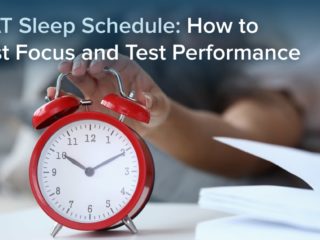| Getting your Trinity Audio player ready... |
When it comes to GMAT prep, simply rereading notes or rewatching lessons can create a false sense of mastery. More effective study methods strengthen our ability to quickly retrieve information from our brains to answer questions. After all, that’s exactly what we’ll be doing on test day! So, what is GMAT active recall, and how can it help you remember information and use it quickly on GMAT exam day?
Quick Answer
Active recall is the practice of pulling information from memory, without looking, then checking and correcting it. For the GMAT, this means quizzing yourself on formulas, CR and RC questions, and DI steps using flashcards, mini-quizzes, and re-teaching spaced over days. It improves retention, reduces careless errors, and speeds up recognition on test day.
Keep reading to see exact prompts for Quant flashcards, a Verbal mini-quiz routine, and a Data Insights re-teach template.
Here are the topics we’ll cover:
- Passive Learning vs. Active Recall
- GMAT Active Recall: Flashcard Method
- GMAT Active Recall: Mini-Quiz Method
- GMAT Active Recall: Re-Teach Method
- GMAT Active Recall: Key Takeaways
- Frequently Asked Questions (FAQ)
- What’s Next?
To start, let’s delve a little deeper into what active recall is and how it differs from passive learning.
Passive Learning vs. Active Recall
Passive Learning
Passive learning is exposure to ideas and concepts without having to retrieve the information from memory.
Examples of passive learning include:
- re-reading notes
- highlighting
- watching solution videos without taking notes
- clicking through multiple-choice answers until one “looks right”
- copying worked solutions and feeling fluent because it “makes sense.”
These things can all be helpful to a degree, but used alone, they create an illusion of mastery over the material. In other words, you may believe that you’ve mastered the concepts you’re studying simply because you recognize them or understand them when reading them.
Passive learning alone risks an illusion of mastery.
Active Recall
Active recall, also known as retrieval practice, involves retrieving information from memory without looking at your notes or materials, and then checking the correct answer. Simply put, active recall is learning through self-testing. Over time, this method builds our retrieval “muscle memory,” allowing us to recall important information more and more quickly — an excellent skill to have on a timed exam such as the GMAT. Some examples of the active recall method are:
- Flashcards: using flashcards with the question/concept on one side and the answer/definition on the other
- Practice quizzes: answering practice questions without your notes, then checking and fixing mistakes
- Re-teaching: teaching a concept out loud from memory and noting what you couldn’t explain
KEY FACT:
Over time, active recall strengthens our ability to retrieve important information from memory more quickly.
Now, let’s get into one of the most tried-and-true methods of active recall: flashcards.
GMAT Active Recall: Flashcard Method
Using flashcards is a study method most students are already familiar with, for good reason: it works! And, it’s an effective component of GMAT active recall. Flashcards are effective because they combine self-testing with immediate feedback.
The flashcard method is straightforward: you write a question or concept on 1 side of the card, write the answer or definition on the back, and then quiz yourself. Simple, right? Well, as simple as this method is, there are ways to optimize it. Here are some dos and don’ts for your GMAT flashcards strategy:
Do:
- Shuffle your decks often. Our minds are adept at recognizing patterns. Shuffling your flashcard deck frequently ensures that you’re not just memorizing answer sequences.
- Review mastered cards less frequently. Keep your deck lean and relevant to your studies. Your deck should evolve as you progress through your prep.
- Use spaced repetition. Spaced repetition is a study scheduling method that means reviewing weak cards more often and well-recalled cards at increasingly longer intervals to reinforce memory just before it fades.
Don’t:
- Include multiple-choice options with your questions. Instead, use questions that work with a single answer on the back of the card. Multiple choices encourage process of elimination and recognition, which are important strategic exam skills — but they’re not the ones we’re working on with active recall practice. Retrieving from memory is the skill we’re trying to build with GMAT active recall.
- Flip the card immediately. Instead, pause and think through the answer. Forcing yourself to answer is a key part of GMAT retrieval practice. This process helps to cement what we’re learning in our long-term memories.
TTP PRO TIP:
Optimize your flashcard use by answering from memory before flipping, shuffling often, and reviewing mastered cards less frequently.
Paper vs. Digital Flashcards
Now, you might be wondering which type of flashcard works best — digital or paper. There are benefits to both formats. Paper flashcards are useful because they’re easy to bring along for quizzing away from home. For example, you can use them to sneak in quick bursts of study while you’re waiting in line or between meetings. On top of that, the act of writing something out by hand helps to reinforce learning. In other words, the act of writing out a paper flashcard can be a form of studying in itself!
That said, there are also helpful digital tools you can use. For example, you can create a GMAT Anki deck using the Anki flashcard app. This will allow you to review your flashcards on your phone or desktop. Anki also uses light gamification, with session completion screens, progress counters, and stats dashboards, elements that can make studying motivating and engaging.
Ultimately, the best flashcard format is the one you’ll actually use — and there’s no reason you can’t use a mix of both.
TTP PRO TIP:
There are benefits to both paper and digital flashcards, so use the format that works best for you.
Next, let’s look at some specific examples of how to use flashcards to study for Quant.
Using Flashcards for Quant
Here are examples of flashcards you could use to test your GMAT quant formula recall:
Card 1: Formula Recall
Front: “Write the percent change formula.”
Back: “Percent change = (new − old) ÷ old × 100%.”
Card 2: In Your Own Words
Front: “Explain percent change in your own words.”
Back: “how much something has increased or decreased compared to its original amount, expressed as a percentage.”
Card 3: Example Question
Front: “Old = 80, New = 92 → percent change?”
Back: “(92 − 80) ÷ 80 × 100% = 12 ÷ 80 × 100% = 15%.”
TTP PRO TIP:
To lock in learning, you can use 3 card types for each formula: the formula, an “in your own words” card, and a quick numeric example.
Let’s move on to another method of active recall: practice quizzes paired with keeping an error log.
GMAT Active Recall: Mini-Quiz Method
Mini-quizzes are simple, brief self-quizzes. While flashcards work best for succinct, 1-idea prompts, the mini-quiz method works well for questions that include multi-paragraph passages. In other words, it’s a great method to use when prepping for the GMAT Verbal section.
Using the Mini-Quiz Method for Verbal
Here’s a 5-step routine for using the mini-quiz method to study for Verbal:
Step 1: Select 3 sample Verbal GMAT questions, either Critical Reasoning or Reading Comprehension, or a mix of both. You can use an app such as Quizlet to create your small study set.
Step 2: Read the passage and select an answer — without notes or other study resources.
Step 3: Mark your level of confidence in your answer (high/med/low). This is an important step. “Low-confidence” correct answers are potential future mistakes. To be safe, we can treat low-confidence answers like misses and revisit them later.
Step 4: Reveal the correct answer and make sure you understand why it’s right. Then, review the logic and the evidence that support the answer.
Step 5: Keep a GMAT error log. Active recall works well when paired with understanding the exact reasons why we answered incorrectly. Specifically, understanding our mistakes reinforces our learning and helps us avoid similar mistakes later.
TTP PRO TIP:
Keep an error log that lists the exact reason you missed each question.
Finally, let’s go over the re-teach method of active recall and how it can be used to study DI questions.
GMAT Active Recall: Re-Teach Method
The re-teach method means explaining, from memory and without notes, a particular concept or exactly how you solved a problem — and then checking yourself. Think of it as a quick explain-it-back to your past self: no notes, no peeking, just you walking through the idea or solution.
Using the Re-Teach Method for Data Insights
DI questions present information in multiple formats, such as tables, graphs/charts, and multi-source tabs. They often require multistep reasoning. That’s why the re-teach method works so well: explaining your solution from memory reveals gaps in your process, weeds out inefficient steps, and locks in correct processes for next time.
Here’s how re-teaching a multistep DI question might look:
After solving a question correctly, explain out loud what path you took to arrive at your answer. For example, “I needed X, so I went to Tab Y, filtered Z, computed ratio A/B, then checked units.”
For any incorrect answers, note the steps you missed and why. Keep each re-teach brief and to the point.
KEY FACT:
Re-teaching is effective because it exposes gaps in your solution process and organizes your thinking.
GMAT Active Recall: Key Takeaways
- Active recall is essentially closed-book self-testing. It involves answering from memory first, then checking and correcting to build faster retrieval and reduce careless errors.
- Three methods of active recall study are: flashcards, mini-quizzes, and re-teaching.
- For the flashcard method, shuffle often, review mastered cards less frequently, avoid multiple-choice on cards, and pause before flipping.
- The mini-quiz method works well for questions that require interpreting multi-paragraph passages, making it a good fit for studying for the Verbal section.
- To use the re-teach method for DI, explain your solution path from memory to reveal gaps and lock in successful steps.
Frequently Asked Questions (FAQ)
What is active recall for the GMAT?
Active recall for the GMAT means answering from memory without notes, then checking and correcting. In practice, use flashcards, mini-quizzes, and re-teaching to drill formulas, Verbal questions, and DI steps.
How is it different from rereading notes?
Rereading notes alone is considered passive learning. It can create an illusion of mastery because you’re absorbing information but not testing your mastery of it. Active recall forces you to pull information from memory.
What tools are best?
Great tools include paper flashcards or apps such as Anki for digital flashcards and Quizlet for practice quizzing.
How do I use active recall for Quant?
One method is to use flashcards to learn high-frequency formulas (e.g., percent change, quadratic formula, and combination formula).
How do I use it for Verbal?
Run a mini-quiz of 3 official questions: commit to an answer, mark confidence (high/med/low), reveal and study why the correct answer is right, and log misses (and low-confidence corrects).
Does it help with studying for Data Insights?
Yes! After solving a question, cover your chosen answer and re-teach the solution path from memory. For incorrect answers, note the steps you missed and why.
What’s Next?
Want more strategies for studying for the GMAT?
For a self-paced roadmap, see our GMAT Study Plan for Self-Learners.
For more GMAT practice methods, check out The Best GMAT Practice Methods.



